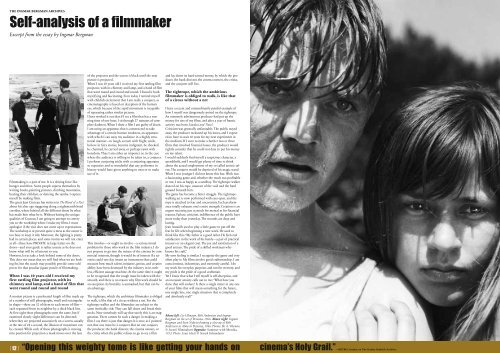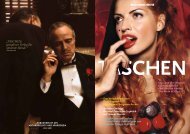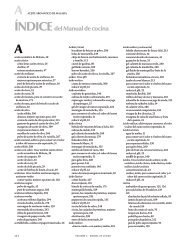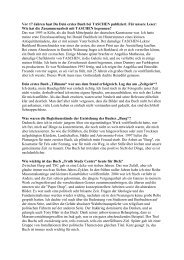“TASCHEN: wonderful publisher of sumptuous tomes.”
“TASCHEN: wonderful publisher of sumptuous tomes.”
“TASCHEN: wonderful publisher of sumptuous tomes.”
Create successful ePaper yourself
Turn your PDF publications into a flip-book with our unique Google optimized e-Paper software.
THE INGMAR BERGMAN ARCHIVES<br />
Self-analysis <strong>of</strong> a filmmaker<br />
Excerpt from the essay by Ingmar Bergman<br />
Filmmaking is a part <strong>of</strong> me. It is a driving force like<br />
hunger and thirst. Some people express themselves by<br />
writing books, painting pictures, climbing mountains,<br />
beating their children, or dancing the samba. I express<br />
myself by making films.<br />
The great Jean Cocteau has written in The Blood <strong>of</strong> a Poet<br />
about his alter ego staggering along a nightmarish hotel<br />
corridor, where behind all the different doors lie what<br />
has made him what he is. Without having the unique<br />
qualities <strong>of</strong> Cocteau, I am going to attempt to convey<br />
you to the workshop where I make my films. I must<br />
apologize if the visit does not come up to expectations.<br />
The workshop is at present quite a mess as the owner is<br />
too busy to keep it tidy. Moreover, the lighting is pretty<br />
bad in certain places, and some rooms we will not enter<br />
at all—these have PRIVATE in large letters on the<br />
doors—and your guide is rather unsure as he does not<br />
know what will be <strong>of</strong> interest to you.<br />
However, let us take a look behind some <strong>of</strong> the doors.<br />
This does not mean that we will find what we are looking<br />
for, but the search may possibly provide some odd<br />
pieces for that peculiar jigsaw puzzle <strong>of</strong> filmmaking.<br />
When I was 10 years old I received my<br />
first rattling film projector, with its<br />
chimney and lamp, and a band <strong>of</strong> film that<br />
went round and round and round<br />
A motion picture is a perforated length <strong>of</strong> film made up<br />
<strong>of</strong> a number <strong>of</strong> still photographs, small and rectangular<br />
in shape—there are 52 <strong>of</strong> them to each meter <strong>of</strong> film—<br />
each separated from its neighbor by a thick black line.<br />
At first sight these photographs seem the same, but if<br />
examined closely slight differences can be detected;<br />
when they are projected successively on a screen, usually<br />
at the rate <strong>of</strong> 24 a second, the illusion <strong>of</strong> movement can<br />
be created. While each <strong>of</strong> these photographs is moving<br />
into position for projection a mask moves over the lens<br />
<strong>of</strong> the projector and the screen is black until the next<br />
picture is projected.<br />
When I was 10 years old I received my first rattling film<br />
projector, with its chimney and lamp, and a band <strong>of</strong> film<br />
that went round and round and round. I found it both<br />
mystifying and fascinating. Even today I remind myself<br />
with childish excitement that I am really a conjurer, as<br />
cinematography is based on deception <strong>of</strong> the human<br />
eye, which because <strong>of</strong> the rapid movement is incapable<br />
<strong>of</strong> separating rather similar pictures.<br />
I have worked it out that if I see a film that has a running<br />
time <strong>of</strong> one hour, I sit through 27 minutes <strong>of</strong> complete<br />
darkness. When I show a film I am guilty <strong>of</strong> deceit.<br />
I am using an apparatus that is constructed to take<br />
advantage <strong>of</strong> a certain human weakness, an apparatus<br />
with which I can sway my audience in a highly emotional<br />
manner—to laugh, scream with fright, smile,<br />
believe in fairy stories, become indignant, be shocked,<br />
be charmed, be carried away, or perhaps yawn with<br />
boredom. Thus I am either an imposter or, in the case<br />
where the audience is willing to be taken in, a conjurer.<br />
I perform conjuring tricks with a conjuring apparatus<br />
so expensive and so <strong>wonderful</strong> that any performer in<br />
history would have given anything to own or to make<br />
use <strong>of</strong> it.<br />
This involves—or ought to involve—a serious moral<br />
problem for those who work in the film industry. I do<br />
not propose to go into the misuse <strong>of</strong> the cinema by commercial<br />
interests, though it would be <strong>of</strong> interest if a scientist<br />
could one day invent an instrument that could<br />
measure how much talent, initiative, genius, and creative<br />
ability have been destroyed by the industry in its ruthless,<br />
efficient sausage machine. At the same time it ought<br />
to be recognized that the rough must be taken with the<br />
smooth, and there is no reason why film work should be<br />
an exception. Its brutality is unmasked, but that can be<br />
an advantage.<br />
The tightrope, which the ambitious filmmaker is obliged<br />
to walk, is like that <strong>of</strong> a circus without a net. For the<br />
tightrope walker and the filmmaker are subject to the<br />
same inevitable risk: They can fall down and break their<br />
necks. Now somebody will say that surely this is an exaggeration.<br />
There cannot be such a danger in making a<br />
film. I say there is just that danger. It is true, as I pointed<br />
out, that one must be a conjurer. But no one conjures<br />
the producer, the bank director, the cinema owners, or<br />
the critics when the public refuses to go to see a film<br />
and lay down its hard-earned money, by which the producer,<br />
the bank director, the cinema owners, the critics,<br />
and the conjurer will live.<br />
The tightrope, which the ambitious<br />
filmmaker is obliged to walk, is like that<br />
<strong>of</strong> a circus without a net<br />
I have a recent and extraordinarily painful example <strong>of</strong><br />
how I myself was dangerously poised on the tightrope.<br />
An extremely adventurous producer had put up the<br />
money for one <strong>of</strong> my films, and after a year <strong>of</strong> frantic<br />
activity was born Sawdust and Tinsel.<br />
Criticism was generally unfavorable. The public stayed<br />
away, the producer reckoned up his losses, and I expected<br />
to have to wait 10 years for my next experiment in<br />
the medium. If I were to make a further two or three<br />
films that involved financial losses, the producer would<br />
rightly consider that he could not dare to put his money<br />
on my talent.<br />
I would suddenly find myself a suspicious character, a<br />
spendthrift, and I would get plenty <strong>of</strong> time to think<br />
about the actual employment <strong>of</strong> my so-called artistic talent.<br />
The conjurer would be deprived <strong>of</strong> his magic wand.<br />
When I was younger I did not know this fear. Work was<br />
a fascinating game and, whether the result was pr<strong>of</strong>itable<br />
or not, I was as happy as a sandboy. The tightrope walker<br />
danced on his rope, unaware <strong>of</strong> the void and the hard<br />
ground beneath him.<br />
The game has become a bitter struggle. The tightropewalking<br />
act is now performed with eyes open, and the<br />
rope is attached to fear and uncertainty. Each performance<br />
totally exhausts one’s entire strength. Creation is an<br />
urgent necessity, just as much for mental as for financial<br />
reasons. Failure, criticism, indifference <strong>of</strong> the public hurt<br />
more today than yesterday. The wounds are deep and<br />
lasting.<br />
Jean Anouilh used to play a little game to put <strong>of</strong>f the<br />
fear he felt when beginning a new work. He used to<br />
think like this: “My father is a good tailor. He feels real<br />
satisfaction in the work <strong>of</strong> his hands—a pair <strong>of</strong> practical<br />
trousers or an elegant coat. The joy and satisfaction <strong>of</strong> a<br />
good artisan. The pride <strong>of</strong> a skilled workman who<br />
knows his craft.<strong>”</strong><br />
My own feeling is similar. I recognize the game and very<br />
<strong>of</strong>ten play it: My films involve good craftsmanship. I am<br />
conscientious, industrious, and extremely careful. I do<br />
my work for everyday purposes and not for eternity; and<br />
my pride is the pride <strong>of</strong> a good craftsman.<br />
Yet I know that what I tell myself is self-deception, and<br />
an incessant anxiety calls out to me: “What have you<br />
done that will endure? Is there a single meter in any one<br />
<strong>of</strong> your films that will mean something for the future,<br />
one single line, one single situation that is completely<br />
and absolutely real?<strong>”</strong><br />
Above left: Liv Ullmann, Bibi Andersson and Ingmar<br />
Bergman on the set <strong>of</strong> Persona, 1966. Above right: Ingmar<br />
Bergman and Sven Nykvist framing a close-up <strong>of</strong> Bibi<br />
Andersson as Alma in Persona, 1966. Photos: Bo A. Vibenius<br />
© Svensk Filmindustri Opposite: Summer with Monika,<br />
1953. Photo: Louis Huch © Svensk Filmindustri<br />
| 12 | “Opening this weighty tome is like getting your hands on cinema’s Holy Grail.<strong>”</strong>—METRO, London, on The Stanley Kubrick Archives






